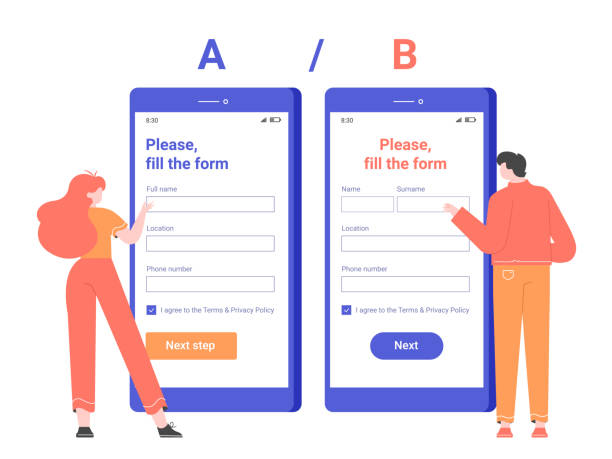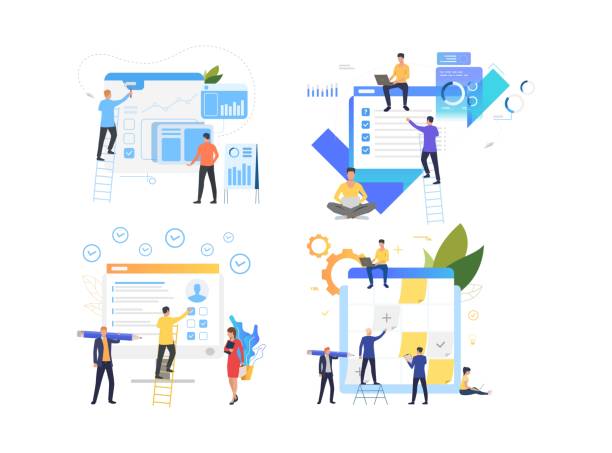Introduction to the Importance of Secure Website Design and Its Challenges

In today’s digital world, where the number of users and the volume of information exchange in the virtual space are increasing daily, secure website design is no longer a luxury choice, but a vital necessity.
Websites, whether for small businesses or large corporations, are the main showcase of activities and a platform for communication with customers and users.
The importance of cyber security in this regard goes beyond just preserving information; it directly affects the reputation, user trust, and even financial stability of an organization.
Any intrusion or security breach can lead to the loss of sensitive data, heavy legal penalties (especially with regulations like GDPR), and irreparable damage to brand reputation.
#Website_Security #Data_Protection #Cyber_Attacks.
Unfortunately, many websites still view security superficially and do not think about strengthening their infrastructure until they are attacked.
Meanwhile, hackers and cyber criminals are constantly inventing new methods to bypass security systems.
Therefore, awareness of existing threats and the implementation of proactive strategies in the early stages of secure website design is crucial.
This article will help you become familiar with the key principles and methods of secure website design and create a website resistant to potential attacks.
From technical aspects of secure coding to user training and incident response planning, all are part of a comprehensive strategy to ensure the stability and security of your website.
Are you dissatisfied with the low sales of your e-commerce site?
Rasaweb is your solution for having a professional and high-selling e-commerce site.
✅ Significant increase in sales and revenue
✅ Easy and enjoyable shopping experience for customers
⚡ Get a free consultation from Rasaweb now!
Identifying Common Vulnerabilities and Potential Weaknesses on the Web

To have a secure and reliable website design, we must first become familiar with the common types of web vulnerabilities.
Identifying these weaknesses is the first step towards prevention and defense.
One of the most common and dangerous vulnerabilities is SQL Injection, which allows an attacker to access the database by injecting malicious SQL code into site inputs, extracting or manipulating sensitive information.
Another vulnerability is Cross-Site Scripting (XSS), where an attacker injects malicious script code into legitimate web pages, and these codes are executed by the victim users’ browsers, which can lead to cookie theft, session information, or page content alteration.
DDoS (Distributed Denial of Service) attacks also aim to take the website offline by sending a massive volume of fake traffic, preventing legitimate users from accessing the site.
These types of attacks require preparedness and secure website design with resilient infrastructure.
Furthermore, Broken Authentication and Session Management, Insecure Direct Object References, and Injection Flaws are other threats that a web developer must pay special attention to.
The specialized content of this section will help you take more effective steps to strengthen your website’s security and prevent serious problems by deeply understanding these vulnerabilities.
Choosing the Right Platform and Architecture for Secure Website Design

The foundation of a secure website design is the selection of the correct platform and architecture.
This decision not only affects the performance and capabilities of your site but also plays a significant role in its resilience against cyberattacks.
When choosing a Content Management System (CMS), options like WordPress, Joomla, and Drupal are available.
Although WordPress is targeted by more attacks due to its high popularity, its security can be significantly increased by using reputable security plugins and correct configuration.
Drupal is traditionally a popular choice for large and governmental organizations due to its strong architecture and focus on security.
In addition to CMS, using web development frameworks like Laravel for PHP, Django for Python, or Ruby on Rails for Ruby, which incorporate secure coding principles, can help strengthen the security foundation.
These frameworks automatically manage many common vulnerabilities.
Server architecture is also highly important; using dedicated servers or VPS with secure configuration, regular updates, and restricted access are fundamental steps towards ensuring secure website design.
The table below provides a comparison of the security features of some popular platforms.
| Security Feature | WordPress | Drupal | Laravel |
|---|---|---|---|
| Update System | Automatic and manual (plugins and core) | Regular and reliable | Managed via Composer |
| Security Community | Very active and large | Focused and professional | Active and expert |
| Internal Security Mechanisms | Password encryption, two-factor authentication (with plugin) | XSS/CSRF Protection built-in, strong access control | CSRF Protection, encryption, Hashing passwords |
| Complexity of Security Implementation | Requires plugins and manual configuration | Very strong and complex | Requires developer knowledge |
| Common Weaknesses | Insecure plugins and themes, incorrect configuration | Complexity in initial configuration | Developer coding errors |
Principles of Secure Coding and Secure Software Development

One of the main pillars of secure website design is adherence to secure coding principles.
Even the best platforms and servers will be vulnerable to cyberattacks if your website’s code has weaknesses.
The first and perhaps most important principle is Input Validation.
All data received from the user, including form information, URL parameters, and cookie values, must be carefully checked and sanitized.
Incorrect validation can lead to attacks such as SQL Injection or XSS.
The second key principle is encryption and hashing of sensitive information.
Passwords should never be stored in plain text in the database; instead, they should be hashed using strong algorithms (like bcrypt or Argon2) along with appropriate salt.
Also, credit card information or other confidential data should be stored and transmitted using strong encryption.
Applying the Principle of Least Privilege means that each user or service should only have access to the minimum resources and permissions required to perform its task.
This approach helps minimize damages from potential intrusions.
Using Prepared Statements for database interaction effectively prevents SQL Injection attacks.
Also, Output Encoding is essential to prevent XSS; meaning any data to be displayed in the page’s HTML must be encoded so that the browser interprets it as text, not executable code.
These specialized topics are the main pillars of developing a secure website design, and every developer must have a comprehensive understanding of them.
Are you dissatisfied with the low sales of your e-commerce site?
Rasaweb is your solution for having a professional and high-selling e-commerce site.
✅ Significant increase in sales and revenue
✅ Easy and enjoyable shopping experience for customers
⚡ Get a free consultation from Rasaweb now!
Database Management and Protection of Sensitive User Information

The database is the heart of every website and contains the most valuable assets: user information, content, and operational data.
From this, secure website design requires special attention to database security.
The first step in this regard is using strong and unique passwords for database user accounts.
These passwords should be changed regularly.
Also, restricting access to the database through firewalls and only allowing communication from authorized IPs can significantly reduce the risk of intrusion.
All sensitive user information, such as passwords, phone numbers, email addresses, and payment information, must be encrypted before storage in the database.
For passwords, as previously mentioned, using strong hashing algorithms with appropriate salt is mandatory.
Data encryption should be applied not only when stored (at rest) but also when in transit, which is achieved using secure protocols like SSL/TLS.
Regular and automatic database backups and storing them in a secure, separate location are vital measures for quick recovery in case of any disaster or attack.
Furthermore, implementing ACL (Access Control Lists) and precisely defining the access level of each user or application to specific tables and data in the database prevents unauthorized access.
Careful management of database logs and monitoring suspicious activities is also an important part of a secure website design strategy.
Network and Server Security for a Secure Web Platform

Secure website design is not limited to coding and databases; network and server infrastructure security also plays a vital role.
Even the most secure codes will be vulnerable on an insecure platform.
Server Hardening is the first step.
This includes removing all unnecessary services and applications, closing unused ports, and correctly configuring the server’s operating system to minimize entry points for attackers.
Firewalls, both software and hardware, play a crucial role in controlling inbound and outbound server traffic and can block cyberattacks before they reach web applications.
Correct firewall configuration to allow only authorized traffic is a powerful preventive measure.
Using SSL/TLS certificates to encrypt all communications between the user’s browser and the server is of paramount importance.
This action not only protects information from eavesdropping but is also beneficial for SEO and builds user trust.
Intrusion Detection and Prevention Systems (IDS/IPS) can also identify suspicious patterns by monitoring network traffic and block attacks before they occur or in their early stages.
Also, regular updates of the server operating system and all installed third-party software, including web servers (Apache, Nginx), prevent known vulnerabilities.
These comprehensive measures provide a strong defensive layer for secure website design.
Maintenance, Updates, and Continuous Monitoring of Website Security

Secure website design is not a one-time process; rather, it requires continuous maintenance, updates, and monitoring.
Cyber threats are constantly changing and evolving, and what is secure today may become insecure tomorrow with the discovery of new vulnerabilities.
Therefore, regular updating of all website components, including the CMS core, plugins, themes, frameworks, and even programming language and database versions, is crucial.
Developers continuously release security patches to fix discovered vulnerabilities, and failing to apply these updates puts your site at risk.
Performing regular security scans and Penetration Testing by security specialists helps identify weaknesses before they are discovered by attackers.
These tests are conducted by simulating real attacks and provide valuable insight into your site’s resistance level.
In addition, monitoring server and application logs to identify suspicious and unusual activities is essential.
Monitoring tools can help you quickly detect attacks, such as repeated failed login attempts or unusual traffic patterns.
This section of secure website design content is more informative and analytical, as we must always be aware of the latest security developments and update defensive strategies accordingly.
| Action | Description | Suggested Timeframe |
|---|---|---|
| Update CMS core and frameworks | Install the latest security patches for the main site platform | Monthly or immediately after release |
| Update plugins and themes | Ensure all secondary components are up-to-date | Monthly or weekly |
| Backup entire site and database | Store complete and recoverable versions in a secure location | Daily or weekly (depending on change frequency) |
| Automated security scan | Use automated tools to identify known vulnerabilities | Weekly or daily |
| Review server and application logs | Monitor suspicious activities and intrusion attempts | Daily |
| Penetration testing (Pentest) | Simulate cyberattacks by specialists | Annually or after major changes |
The Role of User and Internal Team Training in Strengthening Secure Website Design

Even with the best technical implementations in secure website design, the human factor remains one of the biggest vulnerabilities.
Many successful cyberattacks occur not due to system weaknesses, but due to user or staff mistakes or unawareness.
Therefore, continuous training for users and the internal team is an integral part of a comprehensive web security strategy.
This training should include topics such as: the importance of using strong and unique passwords for each service and the necessity of changing them regularly.
Also, users should be familiar with the concept of phishing and other social engineering methods to recognize suspicious emails or messages and avoid clicking on malicious links.
Enabling Multi-Factor Authentication (MFA) for all user accounts with access to the site management system or sensitive information should become a standard, and users should be informed of its importance.
For the development and site management team, more specialized training in secure coding, vulnerability identification, and incident response is essential.
An entertaining story in this regard could be an example of an employee who, by clicking on a phishing link, unintentionally revealed system login credentials, forcing the security team to work for hours to regain control.
These incidents show that security is a collective responsibility, and every individual in the organization must understand and be committed to their role in maintaining secure website design.
Are your e-commerce site visitors leaving before buying? Worry no more! With Rasaweb’s professional e-commerce website design services, solve the problem of converting visitors into customers forever!
✅ Significant increase in conversion rate and sales
✅ Exceptional and attractive user experience
⚡ Contact us now for a free consultation!
Planning for Security Incident Response and Data Recovery

Even with the strongest preventive measures in secure website design, the probability of a security incident never reaches zero.
Therefore, having a comprehensive Incident Response Plan is crucial.
This plan should define specific steps for identifying, containing, eradicating, recovering, and learning from security incidents.
Identification involves detecting if an attack has occurred and what its nature is.
Containment means limiting the scope of the intrusion to prevent damage from spreading, which may include disconnecting compromised sections or isolating servers.
In the Eradication phase, the root cause of the attack is identified and removed, and all weaknesses are patched.
Recovery involves restoring systems to normal operational status using clean backups and performing necessary tests to ensure the problem is fully resolved.
Post-incident analysis is also conducted to identify systemic and procedural weaknesses to prevent the recurrence of similar incidents.
Regular and tested data backups are the cornerstone of any successful recovery plan.
Having multiple copies of backups in different locations (both physical and cloud), and ensuring their restorability, is vital.
This analytical and guiding plan helps you recover from a crisis with minimal damage and greater speed, thereby preserving your reputation, which is an important part of the comprehensive secure website design process.
The Future of Secure Website Design and Emerging Trends

The world of cybersecurity is constantly evolving, and with the advent of new technologies, new challenges and opportunities for secure website design emerge.
One important trend is the role of Artificial Intelligence (AI) and Machine Learning (ML) in cybersecurity.
AI can identify suspicious behavioral patterns with higher accuracy than traditional methods and help predict and counter advanced attacks.
With this, the use of AI in cyberattacks is also increasing, which creates new challenges.
Blockchain technology, with its distributed and immutable nature, has high potential in enhancing data security and digital identities.
It can be used in authentication systems, access management, and even secure storage of sensitive data.
Zero Trust architecture is an approach that emphasizes not trusting any user or device, whether inside or outside the network, and fully verifies all requests before granting access.
This security model is becoming a standard for protecting modern networks and systems.
This section of our content is specifically thought-provoking and analytical, as we explore the future and how secure website design will evolve.
How can we use these emerging technologies to build safer and more resilient websites against future threats? Will these technologies address all security challenges, or will they themselves become the source of new challenges? These questions, and many others, will shape the future of secure website design.
Frequently Asked Questions
| Question | Answer |
|---|---|
| What is secure website design? | Secure website design is a process in which websites are built with security principles in mind to be resistant to cyberattacks and to protect user and business information. |
| Why is secure website design highly important? | To prevent unauthorized data access, sensitive information leaks, malware attacks, loss of user trust, damage to business reputation, and legal consequences resulting from data breaches. |
| What are the most common website vulnerabilities? | SQL Injection, Cross-Site Scripting (XSS), Cross-Site Request Forgery (CSRF), Broken Authentication and Session Management, and Sensitive Data Exposure. |
| How can SQL Injection attacks be prevented? | By using Prepared Statements with parameterized queries, Input Validation, and restricting database access. |
| What are the methods to counter XSS (Cross-Site Scripting) attacks? | User input validation, Output Encoding before displaying in HTML, and using Content Security Policy (CSP). |
| What is the role of HTTPS in website security? | HTTPS encrypts communication between the user’s browser and the website server using an SSL/TLS certificate, preventing eavesdropping, tampering, or forging of data. |
| What are the best practices for user password management? | Enforcing strong passwords (a combination of letters, numbers, and symbols), hashing passwords instead of direct storage (with strong algorithms like bcrypt), and enabling two-factor authentication (2FA). |
| What is the importance of User Input Validation? | Input validation prevents malicious or unexpected data from entering the system, which can lead to vulnerabilities such as SQL Injection or XSS. |
| How do regular security reviews and audits impact site security? | These reviews help identify vulnerabilities and security weaknesses early, allowing them to be addressed before they can be exploited by attackers. |
| What is the use of Web Application Firewall (WAF) in secure website design? | A WAF acts as a protective layer between the user and the website, analyzing incoming traffic and identifying and blocking common web attacks like SQL Injection and XSS. |
And other services of Rasaweb Advertising Agency in the field of advertising
Smart Custom Software: Designed for businesses seeking user engagement through attractive UI design.
Smart Direct Marketing: Designed for businesses looking to increase click-through rates through SEO-driven content strategy.
Smart Marketing Automation: Revolutionize website traffic growth with the help of real data.
Smart Google Ads: Designed for businesses aiming to boost sales through attractive UI design.
Smart Website Development: An innovative service for increasing customer acquisition through marketing automation.
And over a hundred other services in internet advertising, advertising consultation, and organizational solutions
Internet Advertising | Advertising Strategy | Advertorials
Resources
Digiato: How to Secure Your Website?
Zoomit: Best Practices for Secure Coding
ISNA: The Importance of SSL in Website Security
IT Iran: Data Protection Laws in Iran
? For your business leap in the digital world, Rasaweb Afarin is with you. We help your brand grow and be seen by providing innovative solutions in the field of digital marketing. For more information about personal website design and our other services, contact our experts today.
📍 Tehran, Mirdamad Street, next to Central Bank, Southern Kazeroon Alley, Ramin Alley No. 6


